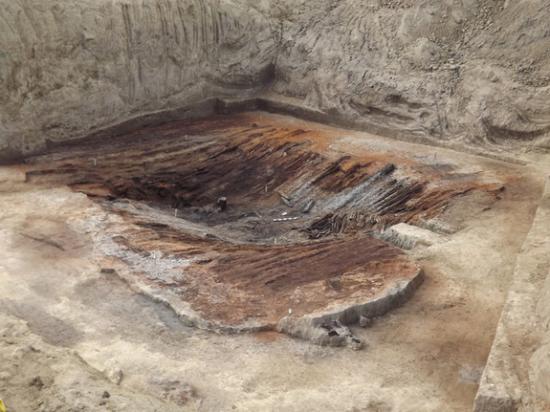Owen Jarus
Source - http://www.livescience.com/46513-ancient-chariot-burial-discovered.html?utm_source=feedburner&utm_medium=feed&utm_campaign=Feed%3A+Livesciencecom+(LiveScience.com+Science+Headline+Feed)

Here, the roof of a 4,000-year-old burial chamber buried in a Kurgan (mound) in the country of Georgia.
Credit: Photo courtesy Zurab Makharadze
An ancient burial containing chariots, gold artifacts and possible human sacrifices has been discovered by archaeologists in the country of Georgia, in the south Caucasus.
The burial site, which would've been intended for a chief, dates back over 4,000 years to a time archaeologists call the Early Bronze Age, said Zurab Makharadze, head of the Centre of Archaeology at the Georgian National Museum.
Archaeologists discoveredthe timber burial chamber within a 39-foot-high (12 meters) mound called a kurgan. When the archaeologists reached the chamber they found an assortment of treasures, including two chariots, each with four wooden wheels.
The team discovered ornamented clay and wooden vessels, flint and obsidian arrowheads, leather and textile artifacts, a unique wooden armchair, carnelian and amber beads and 23 golden artifacts, including rare and artistic crafted jewelry, wrote Makharadze in the summary of a presentation he gave recently at the International Congress on the Archaeology of the Ancient Near East, held at the University of Basel in Switzerland.
"In the burial chamber were placed two four-wheeled chariots, both in good condition, [the] design of which represents fine ornamental details of various styles," Makharadze wrote. Thechamber also contained wild fruits, he added.
While the human remains had been disturbed by a robbery, which probably occurred in ancient times, and were in a disordered position, the archaeologists found that seven people were buried in the chamber. "One of them was a chief and others should be the members of his family, sacrificed slaves or servants," Makharadze told Live Science in an email.
A time before the horse
The burial dates back to a time before domesticated horses appeared in the area, Makharadze said. While no animals were found buried with the chariots, he said, oxen would have pulled them.

Credit: Photo courtesy Zurab Makharadze, cropped by Owen Jarus
Other rich kurgan burials dating to the second half of the third millennium B.C. have also been found in the south Caucasus,said Makharadze in another paper he presented in February at the College de France in Paris. The appearance of these rich burials appears to be connected to interactions that occurred between nomadic people from the Eurasian steppes and farming communities within and near the south Caucasus, Makharadze said.
These interactions appear to have led to some individuals, like this chief, getting elaborate burials. The newly discovered armchair symbolizes the power that individuals like the chief had. "The purpose of the wooden armchair was the indication to power, and it was put in the kurgan as a symbol of power," Makharadze said in the email.
The kurgan was found in eastern Georgia near the municipality of Lagodekhi and was excavated in 2012.
[See Images of the Burial Chamber & Chariots]